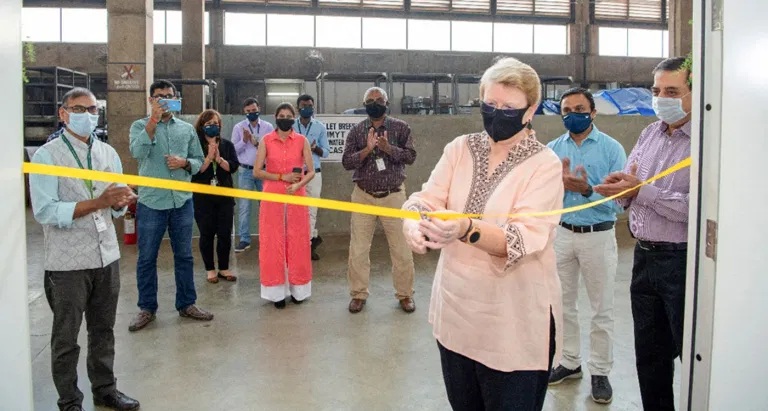ICRISAT’S STATE-OF-THE-ART SEED PROCESSING FACILITIES BEGIN OPERATIONS

Efficient production of high-quality seed for research is an important activity for modern breeding and genebank programs. To bolster this activity, ICRISAT has modernized its seed processing, preparation and grain quality data collection facilities with state-of-the-art machinery and equipment which was inaugurated by Dr Jacqueline Hughes, Director General, ICRISAT, on 18 December.
These facilities, set up by the Crop Improvement Operations Team (CIOT) and Genebank, are part of the institute’s efforts to modernize crop breeding and genetic resources conservation. The seeds are threshed, dried, cleaned and graded by size and sorted by color in the facility. Before storing, the seed moisture content is determined and the seeds are mechanically counted and weighed. The seeds can also be fumigated after threshing or before being put into the cold rooms. Mechanization of seed processing can cut down the time required to process the harvest from one hectare from a month to about 10 days.
“Only the best seed has to be made available to breeders in every generation of varietal development for a breeding program to meet its objectives. Likewise, the material conserved in the Genebank needs to be of the highest quality. These facilities will help us to do so at a reduced cost, with less drudgery, in a faster and a more efficient way while allowing us to dedicate our staff to other important areas,” said Dr Hughes while appreciating the efforts of CIOT and the Genebank team for getting the facility set up and operational during the pandemic.
CIOT was launched in September 2019 by merging technical groups of ICRISAT’s mandate crops into one team to harmonize standards across crops and increase efficiency, keeping in view the larger effort to modernize breeding.
“The CIOT seed processing facility will provide many benefits to breeding programs, including increased productivity and better seed quality for research purposes and seed storage. This facility has enhanced our capacity for efficiently collecting seed and grain data with required accuracy resulting in informed breeding decisions. Overall, processing workflow will be complemented with digitization for efficient tracking, tracing and automation,” said Dr Harish Gandhi, Regional Breeding Lead-Asia and Global Head, Breeding (Interim). He further informed that similar facilities are being developed in regional crop improvement hubs in Zimbabwe and Mali.
“Genebanks are often the starting points in the search for existing and novel traits for breeding programs. Thus, it is imperative that only seeds that meet the requirements of genetic resources conservation are conserved, meaning: with high viability, properly cleaned and free of diseases. By reducing the time taken for processing seeds and increasing the quality of seeds conserved, the overall effort of conservation is strengthened,” said Dr Vania Azevedo, Head, Genebank. The ICRISAT Genebank is one of the largest repositories of dryland crops, with almost 130,000 accessions. For genebank operations seed viability, seed health and moisture content are critical for long-term conservation.
Source : icrisat